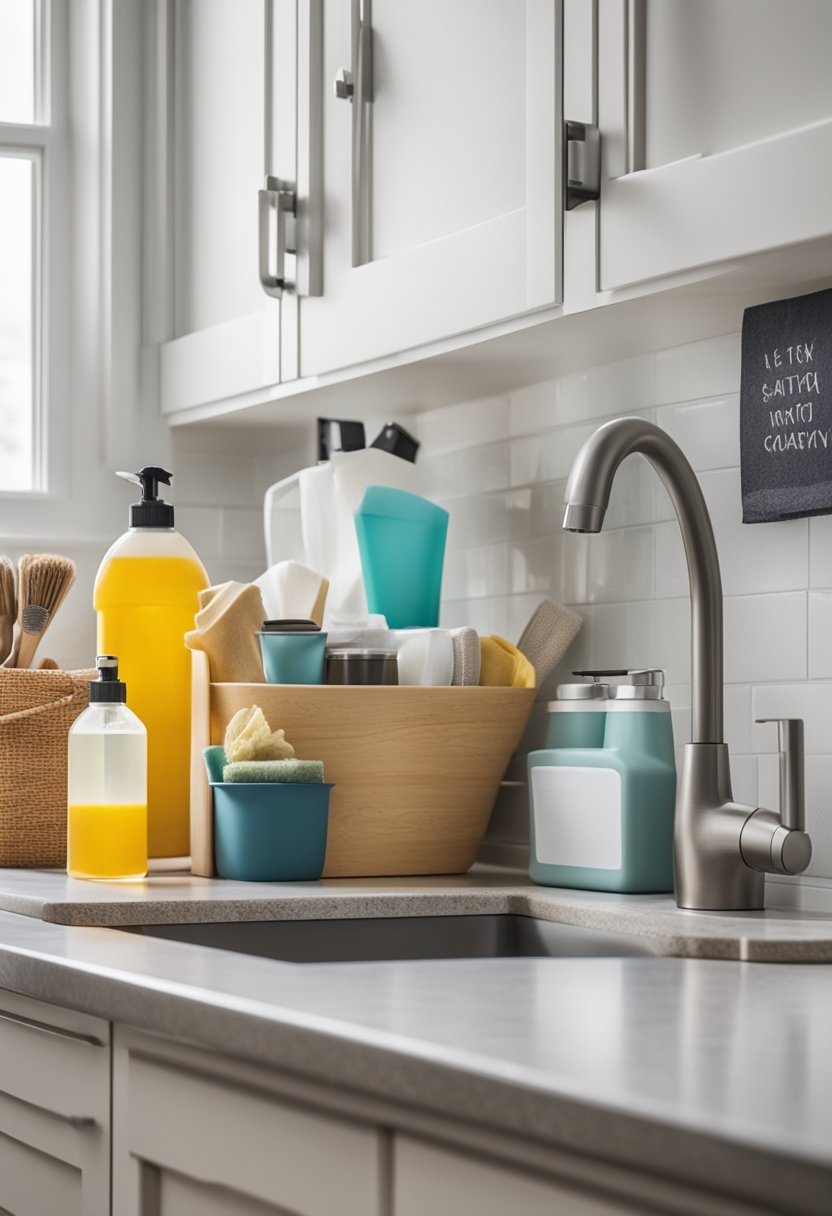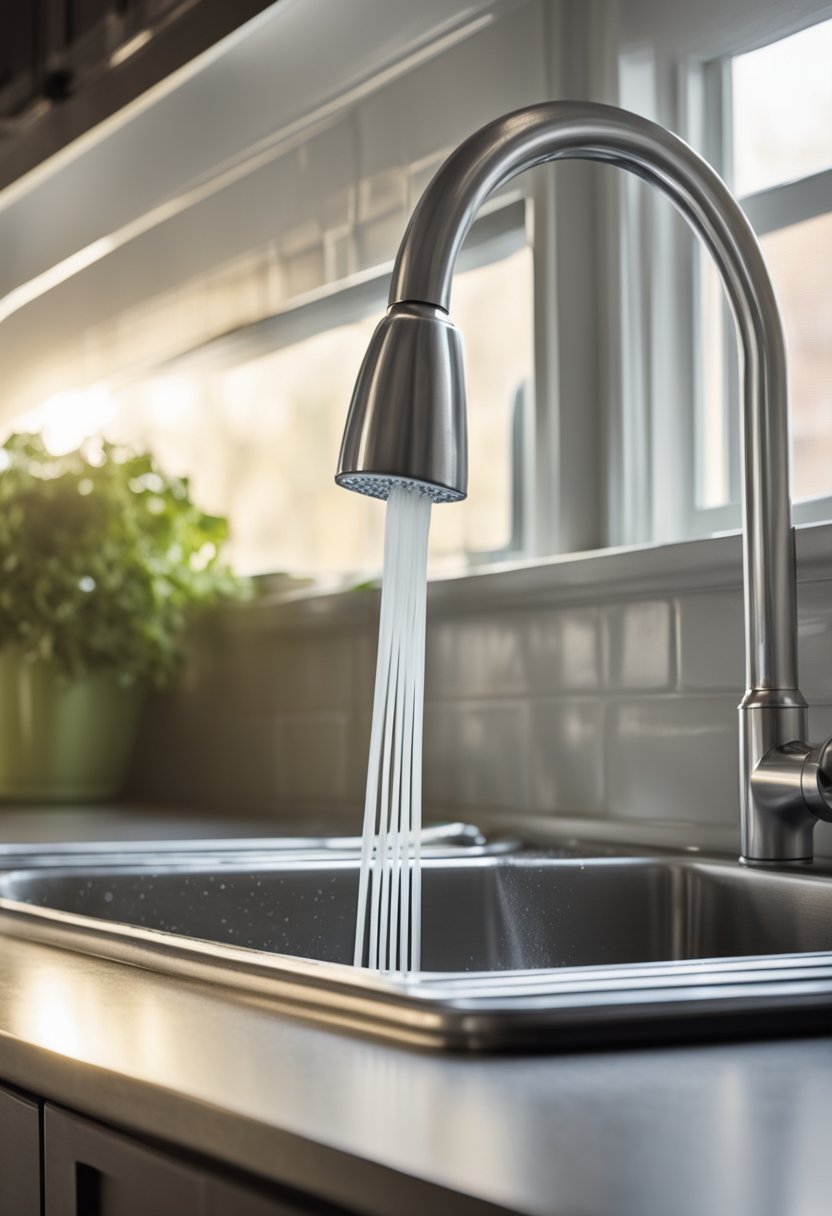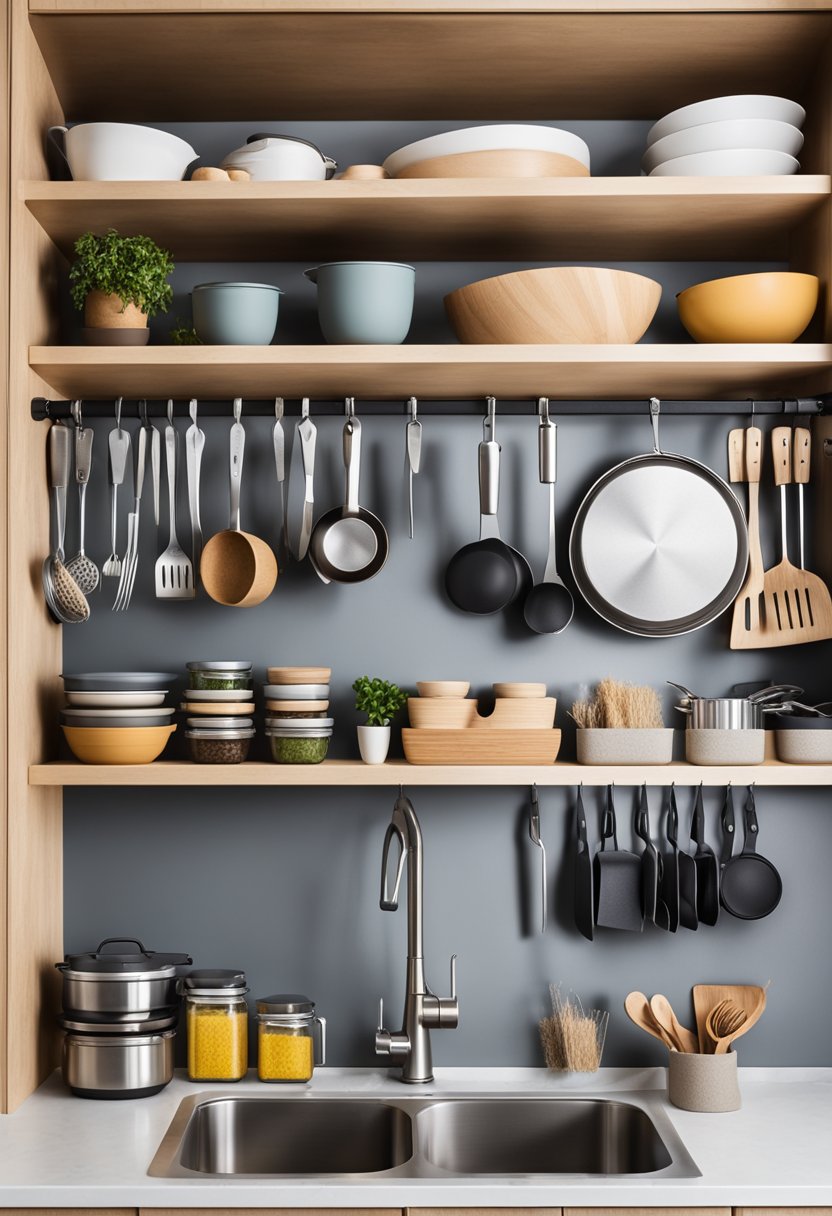10 Tips for a Sparkling Clean Kitchen: Expert Advice for a Pristine Cooking Space
A clean kitchen is not only aesthetically pleasing but also essential for maintaining good health. With so much activity taking place in this space, it’s easy for dirt and grime to build up.
However, keeping a sparkling clean kitchen doesn’t have to be a daunting task. With a few simple tips and tricks, you can transform your kitchen into a pristine space that you’ll love to cook and entertain in.
Decluttering Strategies: The first step towards a clean kitchen is decluttering. A cluttered kitchen can make it difficult to clean and can harbor bacteria and pests.
With smart storage solutions, you can maximize your kitchen space and make it easier to keep clean.
Daily Cleaning Habits: Consistent daily cleaning habits can go a long way in maintaining a clean kitchen.
Simple tasks such as wiping down surfaces, washing dishes, and sweeping the floor can prevent dirt and grime from accumulating.
Additionally, practicing good hygiene habits such as washing hands before cooking and keeping pets out of the kitchen can help keep your kitchen clean and safe.

Key Takeaways
- Declutter your kitchen with smart storage solutions.
- Consistent daily cleaning habits can prevent dirt and grime from accumulating.
- Natural cleaning solutions can be just as effective as chemical cleaners.
Decluttering Strategies
A cluttered kitchen can make cooking and cleaning a daunting task. The following decluttering strategies can help make your kitchen more organized and efficient.
Sorting Kitchen Items
The first step to decluttering your kitchen is to sort through all of your kitchen items.
Start by taking everything out of your cabinets and drawers and sorting them into three piles: keep, donate, and toss.
Be ruthless when deciding what to keep and what to let go of. Keep only the items that you use frequently or that have sentimental value.
Organizing Pantry Essentials
The pantry is often a source of clutter in the kitchen. To keep it organized, start by removing everything from the shelves and sorting them into categories such as baking supplies, snacks, and canned goods.
Use clear containers to store items like flour, sugar, and cereal to keep them fresh and easily visible. Label the containers for easy identification.
Managing Under-Sink Storage
Under-sink storage can also become cluttered quickly.
Use a tension rod to hang cleaning supplies like spray bottles and sponges. Install a pull-out drawer to store items like trash bags and dish soap. Use a small basket to store extra sponges and scrub brushes.
Daily Cleaning Habits

Keeping a kitchen clean requires daily attention to ensure that it remains a healthy and hygienic space for meal preparation. Here are a few daily habits that can help maintain a sparkling clean kitchen.
Wiping Surfaces
Wiping down surfaces after use is a simple habit that can make a big difference in the overall cleanliness of a kitchen.
Use a damp cloth or sponge to wipe down countertops, stovetops, and other surfaces after each use.
For tougher stains or grime, use a mild solution of dish soap and water. 1
Sweeping Floors
Sweeping the kitchen floor daily can help keep dirt and debris from accumulating.
Use a broom or vacuum to remove any crumbs, dust, or other debris that may have fallen on the floor during meal preparation. 2
Dishwashing Routine
A regular dishwashing routine can help keep the sink and countertops clean and free of clutter.
After each meal, rinse dishes and utensils and place them in the dishwasher or hand wash them using a mild dish soap. 3
Footnotes
- Tips and Tricks for Maintaining a Sparkling Clean Kitchen ↩
- Kitchen Cleaning Checklist: Daily, Weekly and Monthly Schedule – TODAY ↩
- Use Our 30-Day Cleaning Checklist for a Sparkling Home ↩
Deep Cleaning Techniques

Keeping the kitchen clean is essential for a healthy home and a pleasant cooking experience. Deep cleaning the kitchen involves tackling tough stains and grime that accumulate over time. Here are some effective deep cleaning techniques:
Degreasing Appliances
Kitchen appliances such as stoves, ovens, and microwaves are prone to grease buildup, which can be tough to remove.
To degrease these appliances, mix equal parts of water and vinegar in a spray bottle.
Spray the solution on the greasy surface, let it sit for a few minutes, and wipe it off with a clean cloth.
For tough stains, use baking soda and water to form a paste. Apply the paste to the stain and let it sit for 15 minutes before wiping it off.
Descaling Sinks and Faucets
Sinks and faucets can accumulate mineral deposits and hard water stains over time, making them look dull and unsightly.
To remove these stains, mix equal parts of water and vinegar in a spray bottle.
Spray the solution on the sink and faucet, let it sit for a few minutes, and scrub it with a soft-bristled brush.
For tougher stains, use a mixture of baking soda and water to form a paste. Apply the paste to the stain and let it sit for 15 minutes before scrubbing it off.
Cleaning the Oven
Cleaning the oven is a daunting task, but it is necessary to keep it functioning properly and avoid any fire hazards.
To clean the oven, remove the racks and soak them in warm soapy water.
Mix baking soda and water to form a paste and apply it to the inside of the oven.
Let it sit overnight and wipe it off with a damp cloth the next day. For tough stains, use a scraper to remove the grime.
Natural Cleaning Solutions

Keeping your kitchen clean and sparkling can be a daunting task, but it doesn’t have to be. Natural cleaning solutions can help you achieve a clean kitchen without using harsh chemicals. Here are a few natural cleaning solutions that you can use to keep your kitchen sparkling.
Vinegar and Baking Soda
Vinegar and baking soda are two of the most versatile natural cleaning agents. They can be used to clean almost anything in your kitchen, from countertops to appliances.
To clean your kitchen countertops, simply mix equal parts water and vinegar in a spray bottle.
Spray the solution on your countertops and wipe them down with a microfiber cloth.
For tough stains, sprinkle baking soda on the countertop before spraying the vinegar solution. Let the solution sit for a few minutes before wiping it away.
Lemon and Salt Scrubs
Lemon and salt scrubs are a great way to clean your kitchen sink and get rid of any odors.
To make a lemon and salt scrub, simply mix salt and lemon juice together to form a paste.
Rub the paste onto your sink and let it sit for a few minutes before rinsing it away.
Not only will this leave your sink sparkling clean, but it will also leave it smelling fresh and citrusy.
Essential Oil Mixes
Essential oils are a great way to add a fresh scent to your kitchen while also cleaning it.
To make an essential oil mix, simply mix a few drops of your favorite essential oil with water in a spray bottle.
Spray the solution on your countertops, appliances, and other surfaces in your kitchen.
Not only will this leave your kitchen smelling great, but it will also help to kill bacteria and viruses.
Smart Storage Solutions

Keeping a kitchen clean and organized can be a daunting task, especially when it comes to storage. Below are some smart storage solutions to help keep a kitchen sparkling clean.
Utilizing Vertical Space
One of the easiest ways to maximize storage space in a kitchen is by utilizing vertical space.
Installing shelves on the walls can provide extra space for storing dishes, cookbooks, and decorative items.
Magnetic knife strips can also be mounted on the wall to keep knives within easy reach while freeing up counter space.
Adjustable Shelving
Adjustable shelving can be a game-changer when it comes to organizing a kitchen.
It allows for flexibility in storing items of various sizes, making it easier to keep things neat and tidy.
Additionally, adjustable shelving can be easily reconfigured to accommodate changes in storage needs.
Drawer Dividers
Drawer dividers are a simple yet effective way to keep utensils, gadgets, and other small items organized in a kitchen.
They can be used in drawers of any size and can be adjusted to fit different types of items.
Dividers can be made of various materials, including bamboo, plastic, and metal.
Preventative Maintenance

Keeping a kitchen clean and sparkling requires regular maintenance.
In addition to daily cleaning, preventative maintenance can help keep surfaces looking new and extend their lifespan.
Here are a few tips on how to maintain your kitchen surfaces:
Sealing Countertops
Natural stone countertops, such as granite and marble, need to be sealed periodically to prevent stains and damage.
Sealing creates a protective barrier that repels liquids and prevents them from penetrating the surface.
It is recommended to seal natural stone countertops every 1-2 years.
To seal a countertop, clean it thoroughly and let it dry completely.
Apply the sealer following the manufacturer’s instructions.
Allow the sealer to penetrate the surface for the recommended time, then wipe off any excess.
Refreshing Cabinet Finishes
Over time, cabinet finishes can become dull and worn.
To refresh them, start by cleaning the cabinets with a mild soap and water solution.
For stubborn stains, use a non-abrasive cleaner.
Once the cabinets are clean and dry, apply a coat of furniture polish or wax to restore the shine.
Alternatively, consider refinishing the cabinets for a completely new look.
Caring for Kitchen Floors
Kitchen floors take a lot of abuse, so it’s important to care for them properly.
Regular sweeping and mopping can help prevent dirt and debris from scratching the surface.
For tile floors, use a non-abrasive cleaner and avoid using steel wool or other abrasive scrubbers.
For hardwood floors, use a cleaner specifically designed for wood floors to prevent damage.
Odor Elimination Techniques

Keeping the kitchen smelling fresh is as important as keeping it clean. Here are some effective odor elimination techniques:
Deodorizing the Refrigerator
The refrigerator can be a major source of unpleasant odors in the kitchen.
To deodorize it, start by removing all the food items and shelves.
Wash the interior with a solution of baking soda and water. Rinse with water and dry the interior with a clean cloth.
Place an open box of baking soda in the refrigerator to absorb any lingering odors. Replace the box every three months.
Neutralizing Trash Can Smells
Trash cans can be a breeding ground for bacteria and unpleasant smells.
To neutralize the smell, sprinkle baking soda at the bottom of the trash can before adding a new bag.
You can also add a few drops of essential oil to a cotton ball and place it at the bottom of the trash can. This will help to keep the trash can smelling fresh.
Freshening the Dishwasher
Dishwashers can develop a musty smell over time due to food particles and soap scum buildup.
To freshen up the dishwasher, start by removing any food particles from the dishwasher drain.
Then, place a cup of white vinegar on the top rack of the dishwasher and run it on the hottest cycle. This will help to remove any lingering odors and buildup.
Eco-Friendly Practices

Maintaining a clean and sparkling kitchen doesn’t have to come at the cost of the environment. By adopting eco-friendly practices, you can reduce waste, recycle, and make use of sustainable cleaning tools. Here are some tips to help you keep your kitchen clean and green.
Reducing Waste
One of the best ways to keep your kitchen eco-friendly is by reducing waste.
You can start by avoiding single-use plastic products such as straws, bags, and utensils.
Instead, opt for reusable alternatives such as bamboo utensils and silicone food storage bags.
When grocery shopping, bring your own reusable bags to avoid using plastic bags.
Another way to reduce waste is by buying in bulk. This not only reduces packaging waste but also saves money in the long run.
You can also compost your food scraps to reduce the amount of waste that goes into landfills.
Composting Kitchen Scraps
Composting is an excellent way to reduce waste and create nutrient-rich soil for your garden.
You can compost your kitchen scraps such as fruit and vegetable peels, eggshells, and coffee grounds.
You can use a compost bin or create your own compost pile in your backyard.
Composting is not only beneficial for the environment but also helps reduce greenhouse gas emissions.
When food scraps decompose in landfills, they produce methane, a potent greenhouse gas.
By composting, you can reduce the amount of methane produced and help fight climate change.
Sustainable Cleaning Tools
When it comes to cleaning your kitchen, you don’t have to use harsh chemicals that harm the environment.
Instead, opt for sustainable cleaning tools such as microfiber cloths, reusable sponges, and natural cleaning solutions.
Microfiber cloths are great for cleaning surfaces without the need for chemicals, while reusable sponges can be washed and reused multiple times.
Natural cleaning solutions such as vinegar, baking soda, and lemon juice are effective at cleaning and disinfecting surfaces. They are also safe for the environment and do not produce harmful fumes.
Tech Aids for Cleanliness
Keeping a kitchen clean can be a daunting task, but with the help of technology, it can be made easier and more efficient. Here are some tech aids that can help keep a kitchen sparkling clean.
Automated Vacuum Cleaners
Automated vacuum cleaners are a great way to keep floors clean without having to manually sweep or vacuum.
These devices use sensors to navigate around obstacles and furniture, and can be programmed to clean at specific times of the day.
Some models even have a mopping function to clean up spills and stains.
UV Sanitizers
UV sanitizers are a great way to keep kitchen surfaces free from germs and bacteria.
These devices use UV-C light to kill up to 99.9% of germs and bacteria on surfaces.
They are easy to use and can be used on countertops, cutting boards, and other surfaces.
Smart Organization Apps
Smart organization apps can help keep a kitchen clean and clutter-free.
These apps can be used to create grocery lists, plan meals, and keep track of expiration dates on food items.
Some apps even have a feature that suggests recipes based on the ingredients you have on hand.
Safety Considerations
Maintaining a clean kitchen is not only important for hygiene and aesthetics but also for safety. Here are some safety considerations to keep in mind while cleaning your kitchen:
Avoiding Cross-Contamination
Cross-contamination occurs when harmful bacteria or germs are transferred from one surface to another.
This can happen when using the same sponge or cloth to wipe different surfaces or using the same cutting board for raw meat and ready-to-eat food.
To avoid cross-contamination, it is important to:
- Use separate cutting boards for raw meat, poultry, and seafood, and ready-to-eat food.
- Use separate utensils for raw and cooked food.
- Wash hands frequently, especially after handling raw meat, poultry, and seafood.
- Use disposable paper towels or clean cloth towels to wipe surfaces.
- Sanitize sponges and cloths regularly by microwaving them for 1-2 minutes or running them through the dishwasher.
Storing Chemicals Safely
Cleaning chemicals can be hazardous if not stored properly.
It is important to read the labels carefully and follow the instructions for use and storage.
Here are some tips for storing chemicals safely:
- Keep chemicals in their original containers with labels intact.
- Store chemicals in a cool, dry, and well-ventilated area away from food and utensils.
- Keep chemicals out of reach of children and pets.
- Do not mix different chemicals, as this can create toxic fumes.
Fire Safety Measures
Cleaning products can be flammable, and kitchen fires can be caused by a variety of factors, including overheated cooking oil, unattended cooking, and electrical malfunctions.
Here are some fire safety measures to keep in mind:
- Keep a fire extinguisher in the kitchen and know how to use it.
- Install smoke detectors and test them regularly.
- Keep flammable items away from the stove, such as paper towels, dish towels, and curtains.
- Never leave cooking food unattended.
- Turn off the stove and other appliances when not in use.






